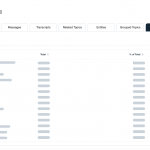Use Technology to Manage & Measure Workforce Engagement
Use Technology to Manage & Measure Workforce Engagement

In the past 50 years, technology has become a fundamental part of our daily lives. From smartphones to online shopping to the tools and systems we use at work, digital tools have automated and simplified repetitive and menial tasks—freeing up precious time so we can focus on more important things.
While technology has certainly gifted us with unprecedented convenience, there’s another side effect: expectation. Customer expectations have increased, and they want a personalized experience and access to things like flawless digital self-service options. These experiences are driven by technology that translates customer data into strategic insights. At Calabrio, we know this data comes from the contact center.
The contact center is a central hub for every touchpoint, giving agents a front row seat to learn about what customers want. Of course, companies want to deliver a customer-centric experience, but making good on that promise starts with a great agent experience. But with new channels being added, agents are feeling the pressure—and it shows no signs of slowing down.
Our Health of the Contact Center Report found that 32 percent of contact center employees believe customer queries and demands will become more complex over time. But agents do not feel prepared with the right tools: 60 percent agree that their company doesn’t always provide the technology needed to address the challenges they face when helping customers. However, a new focus on the employee experience is on the horizon: workforce engagement management (WEM). And it has the power to make or break the agent experience.
Workforce optimization (WFO) is something leaders in our industry already leverage, but the rising importance of employee engagement calls for a new offering—WEM. And this is exactly where our development efforts are focused with Calabrio ONE. WEM technology aims to decrease agent attrition, arm agents with better tools to help customers, route customers to specific agents based on those employees’ areas of expertise and improve agent value and flexibility.
With Calabrio ONE, we’re moving from being purely predictive to prescriptive, which includes anticipating needs and telling people what they want before they know to look for it. Using artificial intelligence and machine learning, we’re helping contact centers automate day-to-day processes, including scheduling and forecasting. For example, by leveraging rule-based automation, businesses can build agents’ schedules faster, automate time-off request approvals and free managers from tedious tasks.
Agents also have more control with intraday management as well as the flexibility to accept overtime or take voluntary time off for unforeseen changes in staffing requirements. Not only that, Calabrio ONE gives agents instant access to comprehensive evaluations so they have the feedback they crave. Through advanced analytics, the contact center can pull employee data to reveal trends that provide more accurate insights into their strengths and weaknesses. As a result, agents have direct understanding of how their performance impacts business outcomes.
At Calabrio, we know how important contact center agents are to the entire customer experience, which is why we’re focused on driving WEM innovation forward. To learn more about the new pressures that contact center agents are facing—and what your business can do about it—download our Health of the Contact Center Report here.
This blog is an abridged version of a full article published on Strategic HR Review on November 15, 2018.









